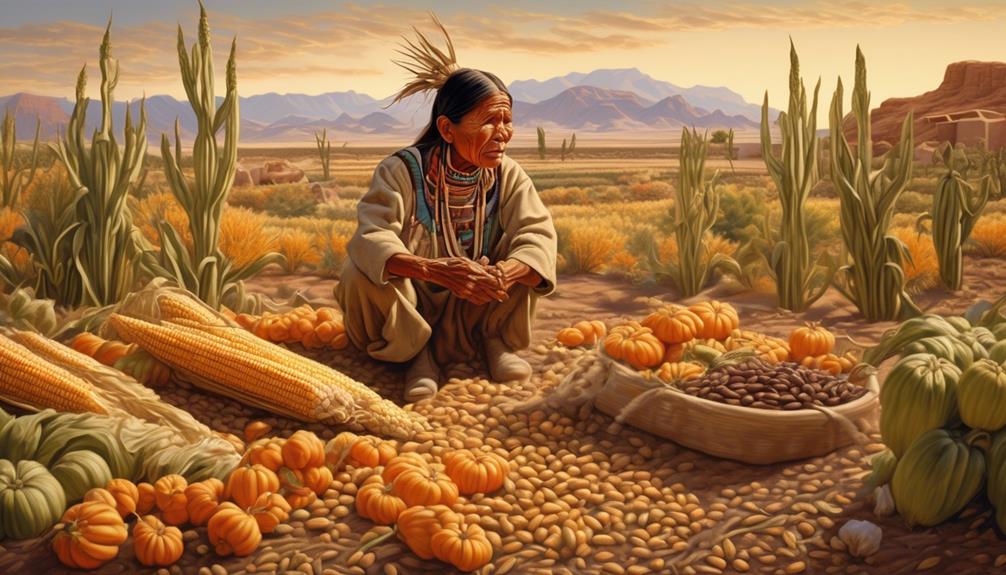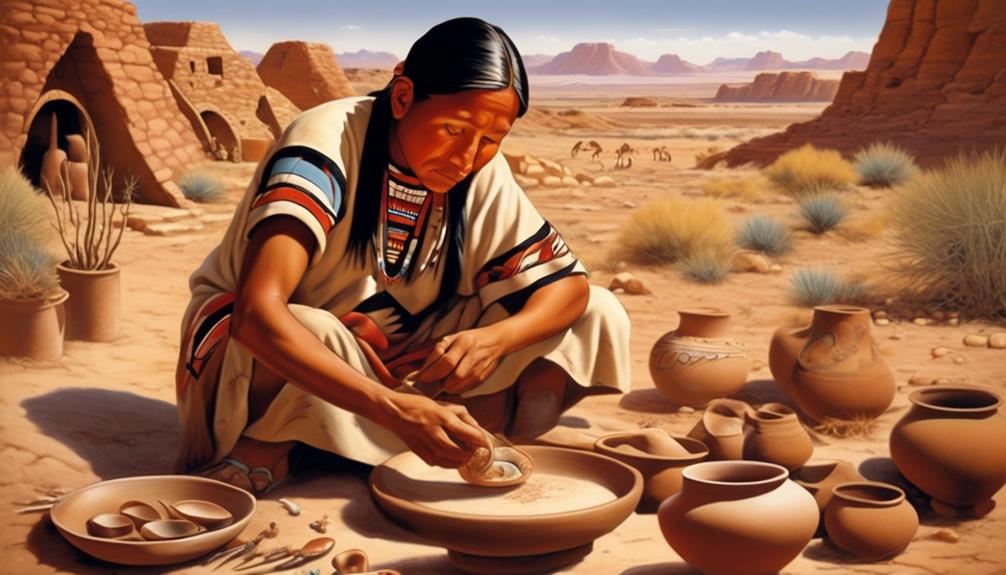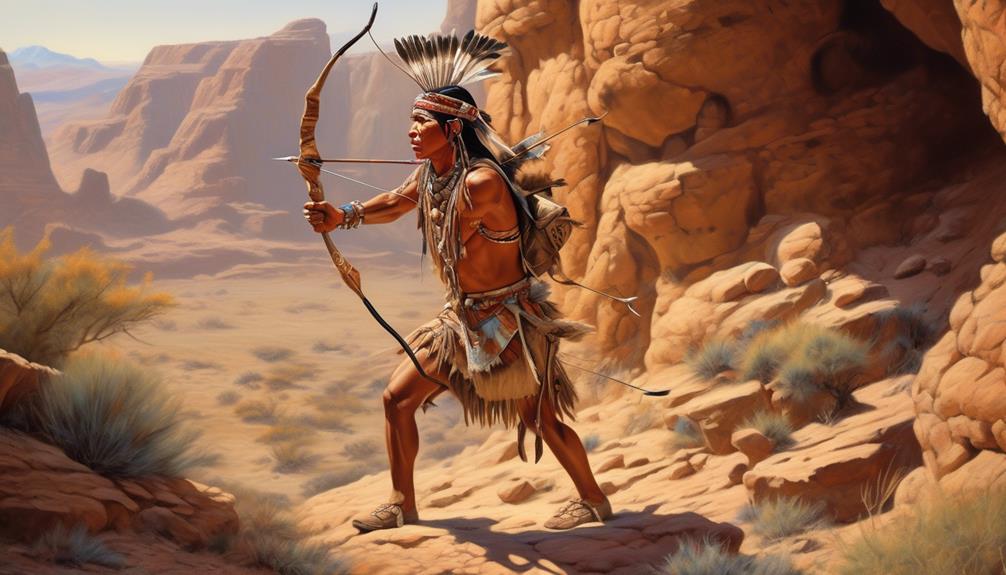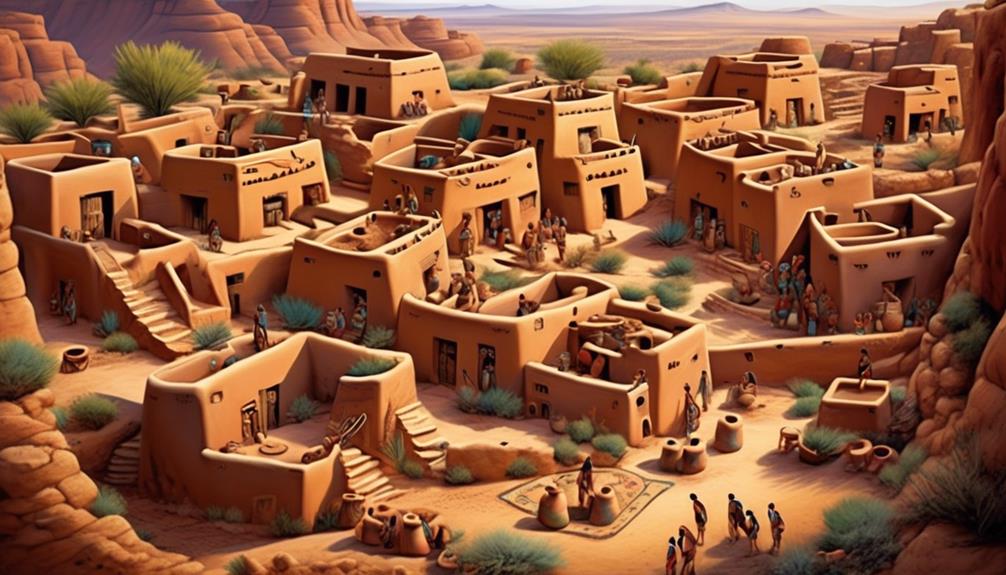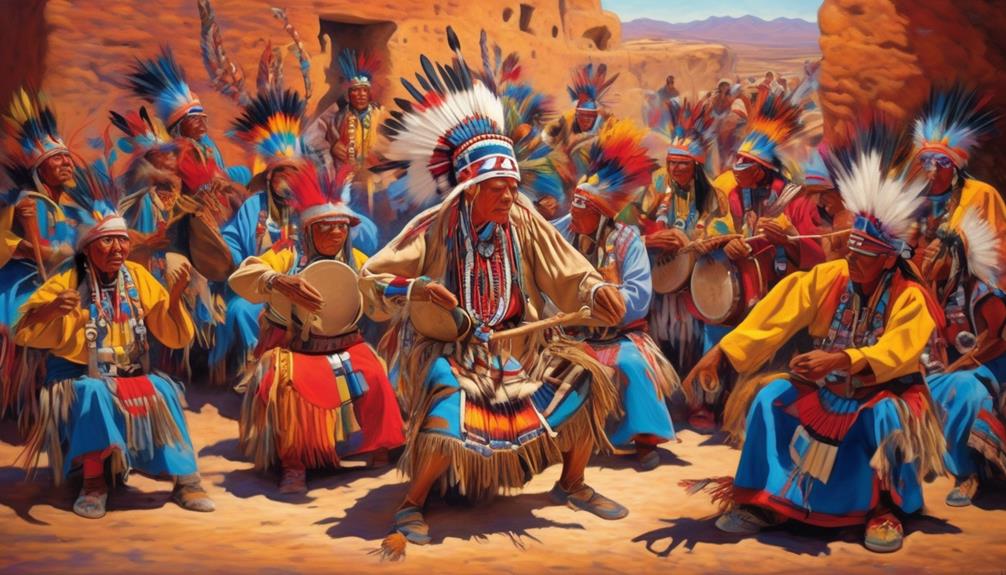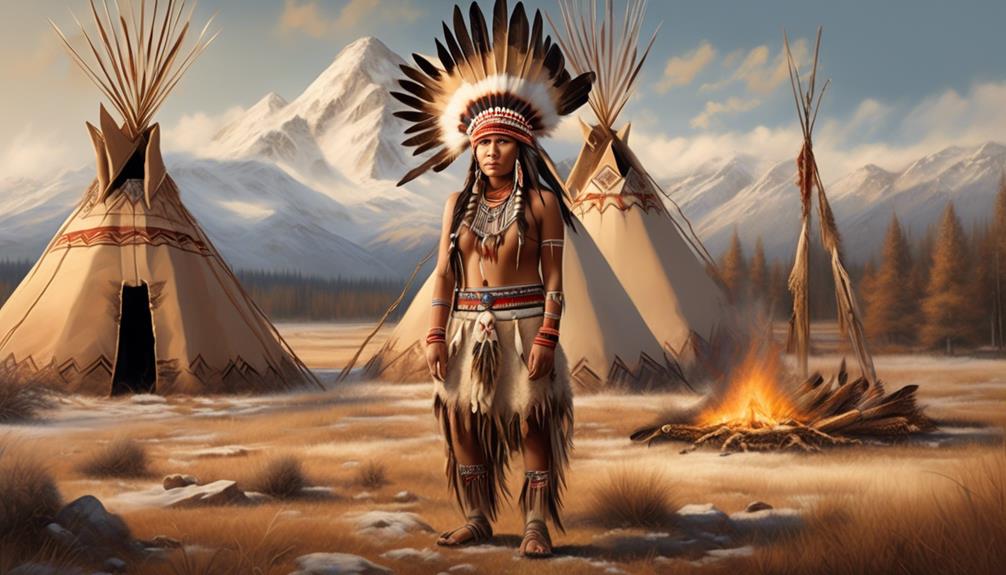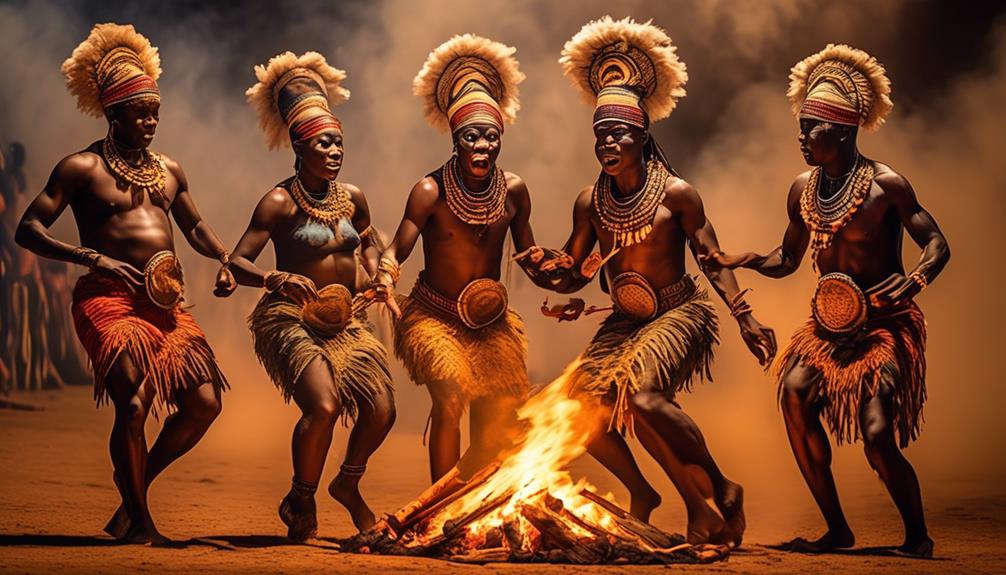The Hopi tribe’s ability to persevere and flourish was likened to the sturdy roots of a towering cottonwood tree, firmly intertwined with the earth and its plentiful resources.
Their methods of sustenance were not only practical but also deeply spiritual, reflecting a profound connection to the earth and its cycles.
As we explore the intricate web of traditional Hopi agriculture, staple crops and farming techniques, utilization of native plants, livestock and animal husbandry, and cultural practices and food preservation, we will uncover a fascinating tapestry of knowledge and ingenuity that sustained this ancient tribe for generations.
Key Takeaways
- Traditional Hopi agriculture relies on sustainable farming methods such as crop rotation, water management techniques, and pest control, serving as a model for environmentally conscious agriculture.
- The Hopi people have a deep understanding of their natural environment and utilize native plants for sustenance, cultural significance, and medicine, while foraging with consideration for the environment.
- Livestock and animal husbandry practices among the Hopi tribe involve rotational grazing, ensuring animal welfare, and are deeply rooted in traditional knowledge, reflecting reverence for the land and animals.
- Hopi cultural practices involve a deep understanding of natural resources and seasonal availability for food preparation, with knowledge passed down through generations. Food preservation techniques such as dehydration, smoking, and fermentation are used to preserve cultural identity and culinary heritage.
Traditional Hopi Agriculture
Traditional Hopi agriculture, deeply rooted in the arid lands of the American Southwest, relies on sustainable farming methods that have been passed down through generations. The Hopi people have developed intricate systems for water management, crucial for cultivating crops in a region with limited water resources. They use a combination of terracing, hand-dug ditches, and check dams to capture and direct rainfall and runoff to fields. This careful water management allows them to make the most of the scarce water available, ensuring the survival of their crops.
In addition to their water management techniques, the Hopi practice crop rotation to maintain soil fertility and prevent soil erosion. By rotating the types of crops planted in each field, they can optimize the use of nutrients in the soil and minimize the risk of depleting them. This traditional practice also helps to control pests and diseases, as different crops have different susceptibility to specific pests and diseases.
The Hopi's careful stewardship of the land and their sustainable farming methods serve as a model for environmentally conscious agriculture.
Staple Crops and Farming Techniques
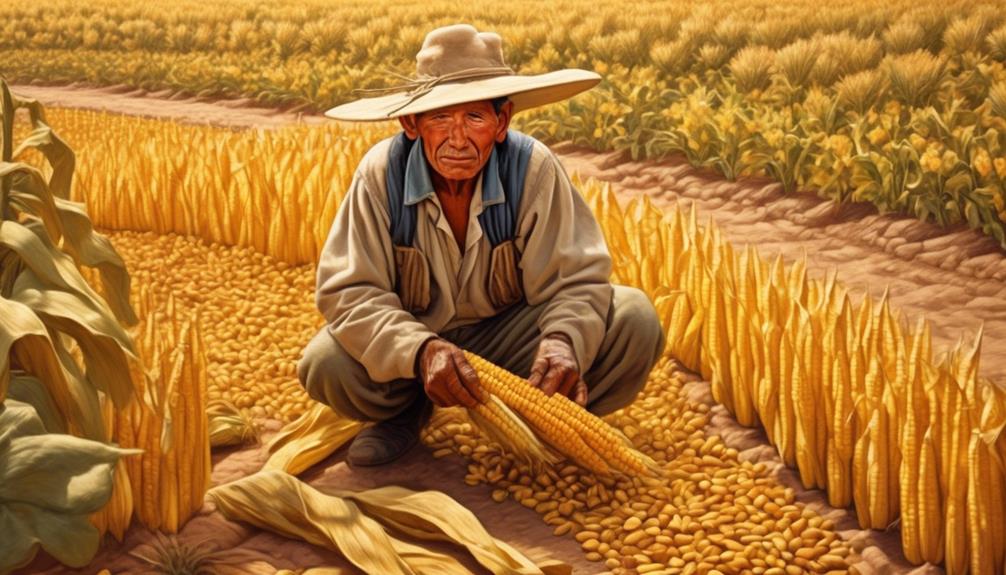
Studying the staple crops and farming techniques of the Hopi tribe provides valuable insights into their sustainable agricultural practices and traditional food sources.
The Hopi people practiced crop rotation, a technique where they alternated the types of crops grown in specific fields to preserve soil fertility and prevent depletion of nutrients.
They also utilized traditional irrigation methods such as gravity-fed ditches to efficiently water their crops, demonstrating their advanced understanding of hydrology and land management.
Additionally, the Hopi tribe employed the use of terracing, constructing earthen terraces on sloped land to create level surfaces for planting, conserving water, and reducing soil erosion.
These farming techniques attested to the Hopi's deep connection to the land and their commitment to sustainable agriculture, ensuring the longevity of their food sources for future generations.
Utilization of Native Plants
The utilization of native plants by the Hopi tribe reflects their deep understanding of the natural environment and their resourceful approach to sustaining their food sources. Native food sources played a vital role in the Hopi diet, and the tribe's foraging practices were integral to their food security. The Hopi people foraged for a diverse array of native plants, including wild herbs, seeds, and fruits, which weren't only used for sustenance but also held cultural and medicinal significance.
Foraging expeditions were conducted with careful consideration for the environment, ensuring the sustainable harvest of native plants. The Hopi tribe's intimate knowledge of the landscape allowed them to identify edible plants and understand their seasonal availability. These foraging practices were passed down through generations, preserving traditional ecological knowledge and fostering a deep connection to the land.
The utilization of native plants exemplifies the Hopi tribe's harmonious relationship with the natural world, showcasing their adaptability and resilience in utilizing local resources to meet their nutritional needs. This approach to food procurement underscores the Hopi people's commitment to sustainable practices and their reverence for the land's offerings.
Livestock and Animal Husbandry
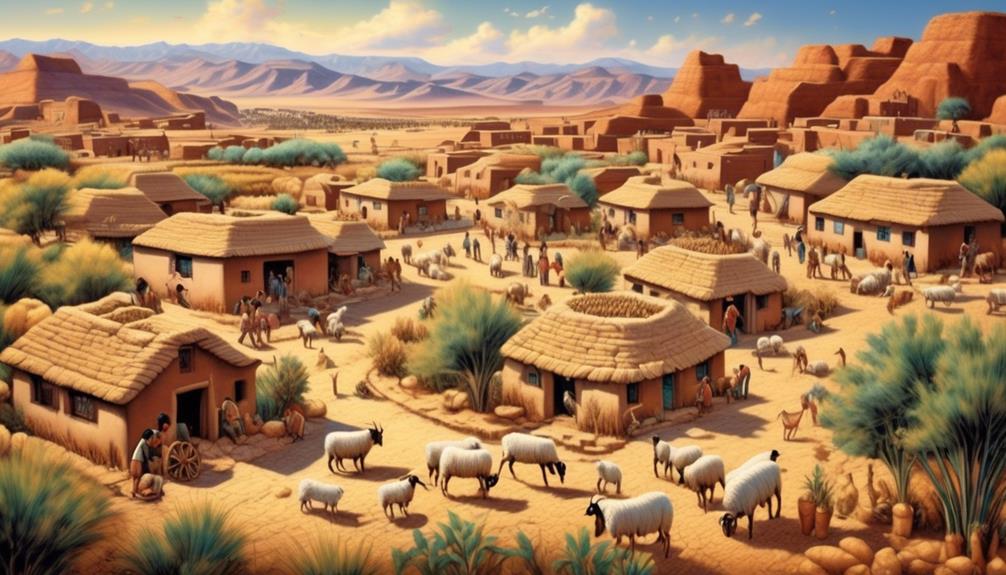
Livestock and animal husbandry play a significant role in the Hopi tribe's sustenance and cultural practices. This aspect of our livelihood encompasses not only the rearing of animals but also the sustainable management of grazing lands. Our approach to livestock management is deeply rooted in traditional knowledge and sustainable grazing practices, ensuring the well-being of both the animals and the land.
- Herding Practices: We practice rotational grazing, moving our herds to different pastures to prevent overgrazing and allow vegetation to regenerate. This sustainable approach ensures that the land can support our livestock for generations to come.
- Animal Welfare: The care and well-being of our animals are paramount. We ensure that they've access to clean water sources and adequate forage, and we closely monitor their health to maintain a thriving and sustainable livestock population.
- Cultural Significance: Livestock and animal husbandry aren't only essential for sustenance but also deeply embedded in our cultural practices and ceremonies. The rearing of animals is interwoven with our traditions, reflecting our harmonious relationship with the natural world.
Our commitment to sustainable livestock management reflects our reverence for the land and the animals that sustain us, ensuring the continuity of our way of life for generations to come.
Cultural Practices and Food Preservation
In our cultural practices, the sustainable management of grazing lands and the rearing of animals intersect with our methods of food preservation, showcasing the interconnectedness of our livelihood and traditions.
Food preparation among the Hopi Tribe involves a deep understanding of natural resources and the seasonal availability of crops. This knowledge is passed down through generations, ensuring the preservation of traditional foodways. Dietary restrictions are also a significant aspect of our food preservation practices, guiding the choices and methods of food preparation.
For instance, the observance of certain ceremonies and rituals may require specific foods to be prepared in traditional ways, respecting cultural and spiritual beliefs. Methods such as dehydration, smoking, and fermentation are employed to preserve food, allowing us to uphold our culinary heritage.
The use of natural resources and traditional techniques not only sustains our dietary needs but also preserves our cultural identity. As a result, our food preservation practices reflect a harmonious balance between honoring our traditions and meeting our nutritional requirements.
Frequently Asked Questions
How Did the Hopi Tribe View the Spiritual Significance of Their Traditional Agricultural Practices?
Viewing the spiritual significance of their traditional agricultural practices, the Hopi Tribe deeply intertwines their spiritual beliefs with sustainable farming. Spiritual practices are central to their agricultural sustainability, as they see the land as a living entity, deserving respect and care.
This connection fosters a sense of responsibility to maintain the balance of nature, ensuring the well-being of future generations. The spiritual significance of their agricultural practices reflects their commitment to harmonious coexistence with the land.
What Were the Specific Roles and Responsibilities of Men and Women in Hopi Agriculture and Food Production?
Gender roles within Hopi agriculture were clearly defined. Men were responsible for tasks such as clearing fields, ensuring irrigation, and building structures for crop storage.
Women, on the other hand, primarily focused on planting, tending to crops, and food preparation.
These traditional methods ensured the sustainability of our agricultural practices and the nourishment of our community. Such division of labor allowed for a harmonious and efficient system of food production within the tribe.
Did the Hopi Tribe Have Any Specific Rituals or Ceremonies Related to Planting, Harvesting, or Food Preparation?
Ritual significance played a pivotal role in Hopi agricultural ceremonies and food preparation techniques. Traditional cooking methods intertwined with sacred rituals, fostering a deep spiritual connection to the land and the sustenance it provided.
The Hopi tribe celebrated planting and harvesting with elaborate ceremonies, honoring the earth's bounty and expressing gratitude. These rituals were integral to the community's food production, fostering a sense of unity and reverence for the natural world.
How Did the Hopi Tribe Handle Food Preservation and Storage During Times of Drought or Scarcity?
During times of drought or scarcity, the Hopi Tribe utilized various food preservation and storage techniques to manage resources. These included traditional agricultural practices and knowledge passed down through generations.
Methods such as drying, smoking, and fermenting allowed for long-term food preservation.
Additionally, communal efforts and careful resource management were crucial in ensuring the tribe's sustenance during challenging times.
Such practices exemplify the wisdom and resilience of the Hopi people in managing food resources.
What Were the Traditional Methods of Food Preparation and Cooking Used by the Hopi Tribe?
Traditional cooking methods of the Hopi tribe were centered around earth ovens and stone griddles. Food preservation techniques included drying, grinding, and storing in pottery. These methods were vital for sustaining our community during times of scarcity.
The earth ovens were used for baking bread and roasting meat, while the stone griddles were ideal for preparing corn-based dishes. These techniques illustrate the resourcefulness and resilience of our ancestors in providing sustenance for the tribe.
Conclusion
In conclusion, the Hopi tribe sustained themselves through a combination of traditional agriculture, native plant utilization, animal husbandry, and cultural food preservation practices.
Their deep connection to the land and their innovative farming techniques allowed them to thrive in the arid environment of the American Southwest.
Their farming methods were as diverse as the colors of a desert sunset, and their dedication to sustainable food production continues to inspire us today.
Mary is a passionate writer who brings creativity and a fresh perspective to our team. Her words have the power to captivate and inspire, making her an essential contributor to our content. Mary’s commitment to storytelling and dedication to promoting Indigenous culture ensures that her work touches the hearts of our readers. We’re fortunate to have her as part of our team.
